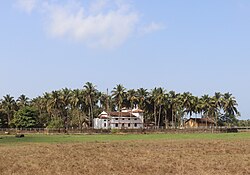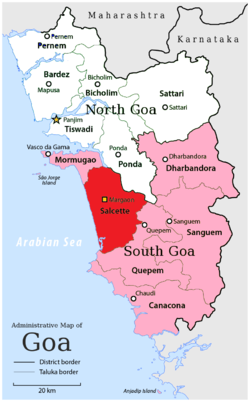Salcete or Salcette (Konkani: Saxtti/Xaxtti) is a subdivision of the district of South Goa, in the state of Goa, situated by the west coast of India.[3] The Sal River and its backwaters dominate the landscape of Salcete.[4] Historically, the sixty-six settlements south of the Zuari River formed the original Salcette territory.[5] Salcete forms a part of the bigger Konkan region that stretches along the western shoreline of peninsular India.[6]
Salcete
Saxtti/Xaxtti Salcette | |
|---|---|
Taluka (subdistrict) | |
 Salcete countryside | |
 Location of Salcete in South Goa, Goa | |
| Coordinates: 15°12′45″N 74°04′24″E / 15.212450°N 74.07323°E | |
| Country | |
| State | Goa |
| District | South Goa |
| Headquarters | Margao (Madgaon) |
| Settlements (as of 2011) | 2 cities 11 towns 35 villages |
| Government | |
| • Deputy Collector | Jyoti Kumari, IAS[1] |
| • Talukadar[1] | Prataprao Gaunkar |
| Population (2011)[2] | |
• Total | 294,504 |
| Demonym | Saxtticar/Xaxtticar |
| PIN | 4036XX, 4037XX |
| Vehicle registration | GA-08 |
In erstwhile Portuguese Goa, the Salcette concelho (county) located in the Velhas Conquistas (Old Conquests) was co-terminous with the undivided Salcette territory (Mormugao and Salcete talukas).[7] In 1917, the concelho was bifurcated into the present-day talukas of Mormugao and Salcete.[8] The contemporary Salcete taluka has been classified as a rurban area.[9] Margao serves as the administrative headquarters of both Salcete taluka and the South Goa district.[10]
Etymology
edit"Salcete" is the modern anglicised spelling of the historical lusitanised version Salcette. This word "Salcette" has been derived from Goan Konkani: सासष्टी, romanized: Sāsaṣṭī—a corruption of the Sanskrit: षट्षष्टि, romanized: Ṣaṭṣaṣṭi, lit. 'Sixty-six' [a].[11] According to the Hindu mythology of the Konkan, the original sixty-six settlements of the Salcette territory were established by sixty-six Saraswat Brahmin clans who had emigrated here from North India.[12] In Goan Konkani, the natives are referred to as Saxtticar or Xaxtticar; साष्टीकार/षाष्टीकार; Sāṣṭīkār/Ṣāṣṭīkār.[3] The Salcete Konkani dialect of southern Goa known as "Saxtti" is notably different from the "Antruzi" (Ponda) and "Bardescari" (Bardez) dialects of northern Goa.[13]
History
editKing Viramarmadeva of the Kadamba dynasty issued a copper-plate inscription in 1049 CE concerning a grant of a piece of land called Tudukapura in Kudtarika agrahara of Chhat sathi desha. This inscription suggests that Chhat sathi refers to modern Salcete, known as "Sāṣṭī" in the local language.[14]
Salcette territory
editHistorical Salcette
editThe original sixty-six settlements of Salcette are as follows:[15]
- Sernabatim
- Vanelim
- Colva
- Seraulim
- Gandaulim
- Duncolim
- Betalbatim
- Nuvem
- Calata
- Gonsua
- Majorda
- Utorda
- Nagoa
- Verna
- Loutulim
- Camurlim
- Ambora
- Raia
- Rachol
- Curtorim
- Nesai
- Macasana
- Guirdolim
- Chandor
- Cavorim
- Paroda
- Mulem
- Sarzora
- Talvorda
- Veroda
- Cuncolim
- Betul
- Velim
- Ambelim
- Assolna
- Cavelossim
- Chinchinim
- Deussua
- Carmona
- Orlim
- Varca
- Sirlim
- Dramapur
- Dicarpale
- Davorlim
- Aquem
- Telaulim
- Navelim
- Margao
- Benaulim
- Adsuli
- Cana
- Mormugao
- Vadem
- Chicalim
- Dabolim
- Sancoale
- Cortalim
- Quelossim
- Cuelim
- Arossim
- Cansaulim
- Velsao
- Pale
- Issorcim
- Chilcona
Contemporary Salcete
editSalcete taluka comprises nine comunidades: Benaulim, Betalbatim, Colva, Curtorim, Loutolim, Margao, Nuvem, Raia, and Verna.
The sub-district consists of two cities, eleven towns, and thirty-five villages as per the 2011 Census of India.
| Salcete Taluka (Census 2011)[2] | ||
|---|---|---|
| # | Settlements | Population |
| Municipal Councils | ||
| 1. | Margao | 87,650 |
| 2. | Cuncolim | 16,623 |
| Census Towns | ||
| 1. | Davorlim | 15,350 |
| 2. | Curtorim | 12,886 |
| 3. | Navelim | 12,323 |
| 4. | Benaulim | 11,919 |
| 5. | Raia | 10,706 |
| 6. | São José de Areal | 10,229 |
| 7. | Nuvem | 9,288 |
| 8. | Chinchinim | 6,908 |
| 9. | Verna | 6,632 |
| 10. | Aquem | 6,511 |
| 11. | Varca | 5,439 |
| Villages | ||
| 1. | Adsulim | 214 |
| 2. | Ambelim | 2,853 |
| 3. | Assolna | 3,410 |
| 4. | Betalbatim | 3,551 |
| 5. | Calata | 1,739 |
| 6. | Camurlim | 2,247 |
| 7. | Cana | 494 |
| 8. | Carmona | 3,864 |
| 9. | Cavelossim | 1,955 |
| 10. | Cavorim | 2,228 |
| 11 | Chandor | 707 |
| 12. | Colva | 3,141 |
| 13. | Deussua | 1,479 |
| 14. | Dicarpale | 3,057 |
| 15. | Dramapur | 3,441 |
| 16. | Duncolim | 748 |
| 17. | Gandaulim | 438 |
| 18. | Gonsua | 222 |
| 19. | Guirdolim | 3,622 |
| 20. | Loutolim | 6,121 |
| 21. | Macasana | 1,972 |
| 22. | Majorda | 2,813 |
| 23. | Mulem | 2,799 |
| 24. | Nagoa | 3,873 |
| 25. | Orlim | 2,049 |
| 26. | Paroda | 620 |
| 27. | Rachol | 1,686 |
| 28. | Sarzora | 2,270 |
| 29. | Seraulim | 3,250 |
| 30. | Sernabatim | 1,548 |
| 31. | Sirlim | 845 |
| 32. | Talaulim | 2,911 |
| 33. | Utorda | 2,018 |
| 34. | Vanelim | 1,860 |
| 35. | Velim | 5,955 |
| Total | 2,94,504 | |
Demographics
editAt the time of the 2011 Census of India, Salcete had a population of 294,464 with sex ratio of 1025 females to 1000 males. Salcete Taluka has an average literacy rate of 89.34%, higher than the national average of 74.04%: male literacy is 92.63% and female literacy is 86.15%. Scheduled Castes and Scheduled Tribes make up 1.17% and 11.06% of the population respectively. 72.15% of the population lives in urban areas.[16]
Religion
editChristianity is followed by the majority of population of Salcete Taluka, and forms over 75% of the population in rural areas. Hindus form a significant minority. At the time of the 2011 Census of India 53.57% of the population of the Taluka followed Christianity, 34.61% Hinduism, 11.38% Islam and 0.19% of the population followed other religions or did not state religion.[17]
Languages
editKonkani and Hindi are among the most spoken languages in Salcete Taluka.
At the time of 2011 Census of India, 71.73% of the population of Salcete Taluka spoke Konkani, 10.52% Hindi, 4.65% Marathi, 3.82% Kannada and 3.20% Urdu as their first language.[18]
Notes
editCitations
edit- ^ a b "Who's Who | South Goa District | India". southgoa.nic.in. Archived from the original on 25 March 2021. Retrieved 15 January 2022.
- ^ a b Chandramouli, C. (2015) [2010–11]. "Salcete Taluka — South Goa". Office of the Registrar General and Census Commissioner, India. Government of India. Census Organization of India. Archived from the original on 15 December 2019. Retrieved 12 December 2019.
- ^ a b Sequeira, Newton (21 December 2014). "The true soul of Goa's South". The Times of India. Archived from the original on 8 December 2016. Retrieved 16 April 2020.
- ^ Nambirajan, M. (2007). Coastal Archaeology of Western India: With Special Reference to Goa. Kaveri Books. p. 134. ISBN 9788174790798.
- ^ Rodrigues 1990, p. 231
- ^ Halarnakar, Tanaji D. (1990). Gram Panchayats in Goa: A Critical Study. Rajhauns Vitaran. p. 48.
- ^ Pandit, Heta; Mascarenhas, Annabel; Koshy, Ashok; Dalvi, Sunita (1999). Houses of Goa (2, illustrated ed.). Architecture Autonomous. p. 15.
- ^ Pinho, Vasco (2007). "Snapshots" of Indo-Portuguese history, Volume 1. p. 122.
- ^ Deshpande, Abhijeet. "Exploring Salcete, places near Margao". Indiatimes.com. The Times Group. Archived from the original on 29 April 2021. Retrieved 30 November 2019.
- ^ Deshpande, Abhijeet. "Margao, the cultural capital of Goa". Indiatimes.com. The Times Group. Archived from the original on 22 December 2018. Retrieved 30 November 2019.
- ^ Macdonell, Arthur Anthony (1929). A practical Sanskrit dictionary with transliteration, accentuation, and etymological analysis throughout. London: Oxford University Press. p. 168.
- ^ De Souza, Teotonio R. (1990). De Souza, Teotonio R. (ed.). Goa Through The Ages: An Economic History, Volume II, Issue VI. Goa University Publication. Concept Publishing Company. p. 6. ISBN 9788170222590.
- ^ Fernandes, Joaquim (15 February 2010). "Saxtti dialect draws the laughs on Konkani stage". The Times of India. The Times Group. Archived from the original on 22 July 2016. Retrieved 30 November 2019.
- ^ Kadamb 2013, pp. 1–14
- ^ Rodrigues 1990, p. 245
- ^ "District Census Hand Book – South Goa" (PDF). Census of India. Registrar General and Census Commissioner of India.
- ^ a b "Table C-01 Population by Religion: Goa". censusindia.gov.in. Registrar General and Census Commissioner of India. 2011.
- ^ a b "Table C-16 Population by Mother Tongue: Goa". censusindia.gov.in. Registrar General and Census Commissioner of India.
References
edit- Kadamb, S. G. (2013). Sources of History of the Kadambas of Goa: Inscriptions (First ed.). Broadway Publishing House. pp. 1–14. ISBN 9789380837314.
- Kosambi, Damodar Dharmanand (1962). Myth and Reality: Studies in the Formation of Indian Culture (reprint ed.). Popular Prakashan. ISBN 9788171548705.
- Rodrigues, L. A. (1990). "The Peninsula of Salcete". In Kusuman, K. K. (ed.). A Panorama of Indian Culture: Professor A. Sreedhara Menon Felicitation Volume. Mittal Publications. pp. 231–246. ISBN 9788170992141.